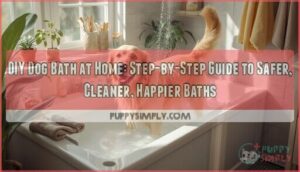This site is supported by our readers. We may earn a commission, at no cost to you, if you purchase through links.

But the rhythm of your pet care routine shapes more than moods—it touches digestion, resilience, even the trust blossoming in small daily moments. Tiny changes ripple fast: a missed walk, a late dinner, and suddenly, anxious eyes search for answers.
Keeping those routines steady does more than smooth the bumps; it helps your pet thrive, day after day, with less stress and more tail wags.
Table Of Contents
- Key Takeaways
- Why a Consistent Pet Care Routine Matters
- Essential Daily Pet Care Tasks
- Maintaining Pet Health and Wellness
- Effective Training and Socialization Strategies
- Tips for Streamlining Your Pet Care Routine
- Frequently Asked Questions (FAQs)
- How can pet owners manage allergies or sensitivities to their pets?
- What are some strategies for managing a pet’s behavior during thunderstorms or fireworks?
- How do I introduce a new pet to my routine?
- What signs indicate my pets routine needs adjusting?
- How do I manage care for multiple pets?
- What to do if I travel frequently for work?
- How can I involve children in pet care routines?
- Conclusion
Key Takeaways
- Keeping a steady pet care routine lowers stress, supports healthy digestion, and helps your pet feel safe.
- Daily habits like walks, meals, grooming, and playtime build trust and make it easier to spot health issues early.
- Regular vet visits, up-to-date vaccines, and staying on top of dental and skin care are key for lifelong wellness.
- Using reminders, organizing supplies, and planning ahead helps you stick to routines—even when life gets busy.
Why a Consistent Pet Care Routine Matters
When your pet knows what to expect each day, life feels safer and calmer. A steady routine does more than keep you on track—it helps your pet thrive inside and out.
A predictable routine helps your pet feel safe, calm, and ready to thrive every day
Let’s look at why a little consistency goes a long way.
Reducing Stress and Anxiety in Pets
Routine stability is peace of mind for your dog. When your days flow in predictable ways, you protect your pet from a rollercoaster of stress. Dogs thrive on familiar rhythms; it’s their anchor.
Simple steps—like environmental enrichment or gentle Human-Pet Interaction—ease pet anxiety, improve pet comfort, and reinforce that essential pet-owner bonding, keeping dog mood steady and behavior calm. Understanding dog stress triggers is essential for maintaining this balance.
Supporting Digestion and Health
Calmer nerves set the stage, and a stable schedule takes digestive wellness even further. When you feed your dog at the same times each day, you sync with their natural rhythm—adults digest a meal in 8–12 hours, and consistency strengthens that flow. Understanding the dog feeding schedule is essential for maintaining their digestive health.
Support your dog’s gut health through:
- Probiotic Benefits: Supplementation lowers cholesterol and balances weight over 12 weeks
- Fiber Intake: High-fiber diets improve stool quality and help dogs feel satisfied longer
- Hydration Needs: Fresh water twice daily promotes smoother digestion and nutrient absorption
Balanced diet choices—paired with enzyme supplements—boost nutrient breakdown, making every bite count for your dog’s health and wellbeing.
Building Trust and Bonding With Your Pet
Strong digestion creates a foundation, and daily routines build something deeper—trust. When you show up at the same time for walks, play, or grooming, your dog learns you’re reliable. Routine interactions like these trigger positive emotional responses and strengthen perceived safety.
Over time, responsive caregiving turns bonding time into a secure relationship. Dog socialization and bonding grow stronger with every predictable moment you share together.
Essential Daily Pet Care Tasks
Taking care of your pet doesn’t have to feel overwhelming when you break it down into manageable daily tasks. A few simple habits—done consistently—can make a real difference in your pet’s health and happiness.
Let’s look at the core tasks that should be part of every day with your furry companion.
Feeding and Hydration Schedule
A regular feeding schedule isn’t just about convenience—it helps you spot health problems early and prevents obesity. Most adult dogs do well with two meals daily, while puppies need three to four.
Feeding frequency and food type both affect water hydration needs. Always provide fresh water throughout the day, adjusting for environmental factors like heat and activity levels.
Exercise and Physical Activity
Nearly every dog needs a daily dog walk, though the right activity duration depends on breed specifics and age. For instance, high-energy dogs crave vigorous exercise routines, while seniors benefit from short, gentle walks.
Don’t overlook indoor exercise or creative exercise ideas—fetch, tug, or puzzle games. Exercise benefits reach far beyond fitness, supporting good behavior, joint health, and happy minds.
Dental Care and Hygiene Practices
Good oral care isn’t just about fresh breath—it’s central to dog dental health. A few simple routines make a big difference:
- Brush with a pet toothbrush for best results
- Try Dental Chews or VOHC-approved treats
- Watch for gum disease signs
- Follow regular veterinary advice on dental hygiene
- Don’t skip annual professional cleanings
Sticking to these Oral Health Tips promotes everyday wellbeing.
Mental Stimulation and Enrichment
Curiosity comes naturally to dogs, just like kids. When you offer mental stimulation with puzzle toys and new scents, you spark their cognitive development and ease stress.
Environmental enrichment—whether it’s interactive play or a simple game of hide-and-seek—challenges their problem-solving skills and keeps boredom at bay. These mental enrichment moments help your dog feel sharp, calm, and truly fulfilled.
Maintaining Pet Health and Wellness
Keeping your pet healthy takes a little planning but goes a long way. There are a few basics every owner should work into their daily routine.
Here’s what matters most regarding your pet’s health and wellness.
Regular Veterinary Checkups
Ever wondered why missing even one Vet Checkup can spell trouble down the line? Vet Visit Schedules aren’t just boxes to tick; they’re lifelines.
Regular veterinary care means catching problems—sometimes long before your pet looks or acts sick. You’ll find that a smart Veterinary Care Plan, with routine Checkup Frequency, makes Disease Prevention part of your daily Pet Health Monitoring.
Vaccinations and Preventative Care
Think of Vaccine Schedules and Parasite Control as your shield against hidden pet health issues. Staying on top of vaccinations and preventative care, including regular Heartworm and flea meds, makes a world of difference. Here’s my top-3 checklist:
- Keep Health Screenings and vaccinations up to date.
- Practice daily Dental Hygiene.
- Stick to recommended Medication Management.
Grooming and Skin Health
Ever notice how brushing a dog isn’t just about pretty fur? Grooming frequency shapes coat health and combats hidden skin conditions—especially in breeds with tricky hair types.
Many owners face grooming barriers, whether it’s tool costs or product effects like dryness. Still, regular fur brushing and gentle hygiene go a long way toward a happy, comfortable pup.
Managing Seasonal Allergies and Conditions
While grooming keeps skin healthy, seasonal allergies turn ordinary days into scratchy ones. Tree and grass pollen, mold, and fleas flare up with the seasons—leaving itchy pets and worried owners. Here’s how to manage:
- Schedule allergy testing early.
- Practice home controls—HEPA filters work wonders.
- Use prescribed symptom relief baths or wipes.
- Prioritize year-round flea prevention.
Effective Training and Socialization Strategies
Training and socialization play big roles in your dog’s everyday happiness. These strategies build good habits and help your pet feel confident in different situations.
Let’s look at some practical ways you can set your dog up for success.
Obedience Training and Good Manners
Raising a well-mannered dog starts with steady obedience training and a sense of routine. Through everyday lessons in canine etiquette and creative training games, you help shape calm behavior, reinforce pet discipline, and invite better social skills. Even short, frequent practice with structured training methods makes dog obedience much smoother and builds a trusting bond, all while making behavior modification feel like second nature.
| Training Method | Benefit for Your Dog |
|---|---|
| Daily routines | Reduces stress |
| Consistent cues | Encourages good manners |
Positive Reinforcement Techniques
Let’s build on those daily training routines by embracing Positive Reinforcement. Reward Based Training, such as Clicker Methods or simple praise, engages canine learning through Operant Conditioning. This approach also shapes good dog behavior and makes training games more fun. Notice your dog’s tail wag more with:
- Timely treats
- Cheerful encouragement
- Gentle, consistent feedback
Socializing With People and Other Pets
A treat or cheerful word does wonders in Dog training and socialization, but real progress shines during Animal Encounters at places like Dog Parks or Community Events.
Time with other pets builds true Social Skills, easing anxiety and boosting well-being. Shared bonding time during these outings is how pet socialization blossoms, helping dogs feel secure among friends—both furry and human.
Tips for Streamlining Your Pet Care Routine
Keeping up with your pet’s routine can feel overwhelming, especially when life gets busy. There are simple ways to cut down on daily hassles and keep things running smoothly. Here’s how you can make your pet care routine easier every day.
Using Technology and Reminders
Staying on top of your pet care routine is easier than ever. Digital Reminders and Pet Wearables help you track every meal, walk, and medication. Smart Feeders manage diets, while Automated Care and routine tracker apps keep your dog’s routine and consistency on point. Even Virtual Consults fit into daily care routines, giving peace of mind when life gets hectic.
Organizing Pet Supplies and Spaces
Order in your pet’s world starts with smart Storage Solutions. Dedicated Pet Stations turn chaos into calm, making daily routines sharp and stress-free. Tidy bins or marked shelves mean you grab supplies fast.
Monthly Supply Management and designated cleaning zones help you maintain healthy spaces—key Organization Tips that make responsible pet ownership smoother, safer, and, yes, downright simpler for everyone.
Staying Consistent When Life Gets Busy
Life’s pace shifts quickly—plans change, work calls, and suddenly, the dog care routine slips. Busy Pet Owners thrive by weaving Routine Automation into their days. For true Stress Reduction and dog consistency, try:
- Automated phone reminders
- Trusted Pet Sitters on standby
- Grouping pet chores
- Clear labels for essentials
These small habits safeguard your dog’s predictability, health, and happiness.
Frequently Asked Questions (FAQs)
How can pet owners manage allergies or sensitivities to their pets?
When pet dander drifts through your home like dust on a sunbeam, managing allergies takes a clever plan.
Allergen reduction, HEPA filters, immunotherapy, and hypoallergenic diets all help curb pet health issues and support stronger preventative care.
What are some strategies for managing a pet’s behavior during thunderstorms or fireworks?
During thunderstorms or fireworks, give your dog a safe hideaway and try Calming Techniques like an Anxiety Wrap or pheromone diffuser.
Positive treats, structured desensitization, and routine are all solid tools for Panic Prevention and easing Noise Phobia.
How do I introduce a new pet to my routine?
When bringing a new dog home, keep introductions calm and gradual. Stick to your existing dog care routine, providing predictability and security.
Use stress reduction strategies like positive reinforcement and personal space. Consistent daily care routines support smooth household integration.
What signs indicate my pets routine needs adjusting?
Watch for changes like increased barking, appetite shifts, sleep troubles, or destructive chewing.
These routine disruptions and stress signals suggest it’s time to revisit your dog’s daily routine and tailor your pet care routine for better well-being.
How do I manage care for multiple pets?
Managing multiple pets means weaving together pet scheduling and care coordination for smoother days.
Sharing responsibilities with all family members builds a stronger bond, aids dog care and pet wellness plans, and keeps your daily care routine efficient in Multi Pet Homes.
What to do if I travel frequently for work?
Frequent travel for work means leaning on Pet Sitters, Remote Monitoring, and Automated Feeders for consistent care. Pet Hotels can reduce travel anxiety, while reliable routines—like regular dog walking and exercise—improve pet safety and identification.
How can I involve children in pet care routines?
Isn’t it rewarding to watch your kids step up as helpers? Pet Chore Charts, Kid Friendly Tasks, and Family Involvement create Youth Engagement and Child Responsibility, building strong habits for dog care, dog health, and responsible pet ownership.
Conclusion
If you think a pet care routine is as simple as setting a clock, you’re aiming too low—it’s more like gently tuning an instrument your pet’s whole world depends on. Each small habit—meals, exercise, or quiet moments—plays a note in a song written just for your furry friend.
With steadiness, you give your pet a life less ruled by worry and more by wagging joy, where every day feels safe, expected, and full of trust.
- https://www.petfoodindustry.com/pet-food-market/market-trends-and-reports/news/15741428/report-pet-ownership-expands-as-gen-z-shifts-trends
- https://www.avma.org/news/pet-population-continues-increase-while-pet-spending-declines
- https://vetmed.tamu.edu/news/pet-talk/proper-pet-hygiene/
- https://pwcosi.com/must-know-daily-care-routines-for-dogs-cats-and-other-pets-seasonal-tips/
- https://mhanational.org/resources/add-your-pet-to-your-daily-routine/













